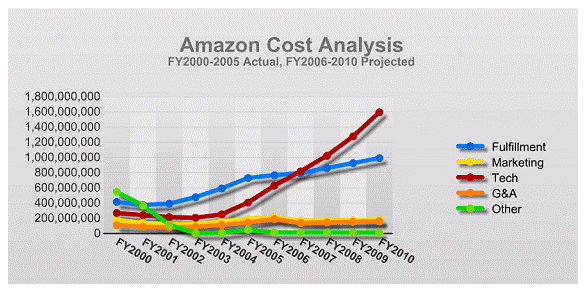Online and Search Costs: Confronting the Unknown
Stephen E. Arnold, president of ArnoldIT.com and a consultant to Gerson Lehrman Group, specializes in online and search. He is the author of The Google Legacy and numerous books on the Internet. The following is derived from his forthcoming monograph to be issued in late 2006. Contact him at sa@arnoldit.com.
Winning in the marketplace for in search and online access these days takes more than fielding better technology to attract customers. It requires the expertise to keep technology and other costs in hand and the willingness to go head to head with things that go bump in the night.
Costs matter –and increasingly--because online and search are experiencing enormous changes that drive expenditures upward. Such changes include, for example, new features and functions that result in more programming, hardware advances that lead to system upgrades, and the appearance of new competitors requiring the adoption of rich media that in turn demands increased outlays for storage, bandwidth, and servers.
How much do costs matter? Two examples provide a reference point.
In 2000, the U.S. government began work on FirstGov--a search and retrieval system enabling citizens to look for information on thousands of government agency Web servers. Program costs for the initial year were an estimated $500,000. By 2005, program costs had spiraled upward and were expected to exceed $20 million, according to one person familiar with the program.
Amazon is a second example. The diagram below plots Amazon's reported expenses from its 10-K reports for the period from its FY2000 to FY2005.
|
|
The diagram clearly shows that Amazon’s management has to manage the company’s technology investments. The trend for technology costs, as graphed, could weaken Amazon, perhaps fatally. This trend may be one reason that, as of this writing, Amazon’s stock is trading at about half its 52-week high.
The spiraling costs of these and other organizations highlight several issues with which executives at search and online companies must deal. One issue is that search and online cost more the longer a company is successful. As more data are processed by the system, more infrastructure, programming, and money are needed to store and serve those data. Ultimately, it costs more money to support the revenue engine than the revenue engine can generate. In response, online companies are forced to scale back services and cut corners. In time, customers opt for competing products.
Another issue involves leadership costs. In search and online, it costs more to stay ahead than to get ahead. What was good enough to create today’s leader becomes a legacy that makes it very difficult for that company to be tomorrow's leader. The time and cost required to innovate anew are viewed as excessive.
The process of getting a grip on costs begins with identifying and understanding them. The below table provides an inventory of some typical costs and places them in three categorizes based on the likelihood of estimating them correctly. Known costs are, obviously, quantifiable with high precision, while unknown costs are those for which only some generalized estimate can be derived. Category 3 costs are the unknown unknowns—events unforeseeable and hence not subject to quantification. (A more complete inventory is available on request.)
|
Online Cost Inventory—A Partial List |
|||
|
Type |
Expense |
Definition |
Characteristics |
|
Known |
Licensing |
Recurring costs associated with third-party software, including maintenance and upgrades |
Easy to budget. Services component may add additional costs. |
|
Known |
One-time costs |
Capital expenditures or other disbursements to handle a specific problem or opportunity; e.g., buy any unbudgeted item or service |
Easy to budget. These are the initial assumptions and the costs associated with starting a new service. |
|
Known unknown |
Bandwidth |
Shorthand for infrastructure, connectivity, and facilities |
Costs governed by Service Level Agreements with specific clauses and price lists to address surges in demand, outages, etc. |
|
Known unknown |
Fraud detection |
People, system, infrastructure, and recurring costs to protect financial assets |
Magnitude of the task becomes evident after an unplanned event. |
|
Unknown unknown |
Environmental factors |
Change in the market or broader economic or social ecosystem that are beyond the control of any one organization |
Unpredictable. May become an issue after a period of gestation. |
How best to deal with these cost factors? Three broad-based approaches merit consideration by search and online access executives in their pursuit of cost control:
1. Innovate: Develop a search and online system that maximizes performance while minimizing expense.
2. Model: Using data collected from your own organization and others, produce a series of scenarios. Select the most sensible scenario for your operation.
3. Refine: Facing insufficient resources, revisit and revise the estimates. Avoid underestimating since overstating costs is better than underallocating resources.
4. Emulate. Look at what makes Google tick and use the techniques that help hold down operational costs.
Given the pace of change, the outlook for controlling costs of online access and search companies is not good. Moreover, risks associated with dealing with the unknowns can be as great if not greater than those connected with second-guessing the unexpected. In an environment of spiraling costs, however, one thing seems certain: confrontation avoidance looms as the greatest risk of all.
# # #
